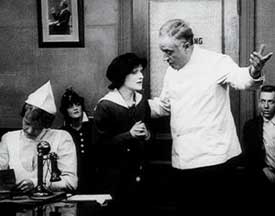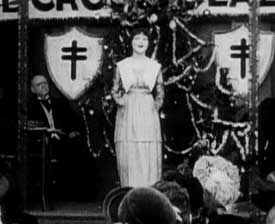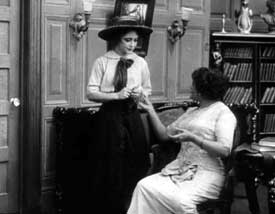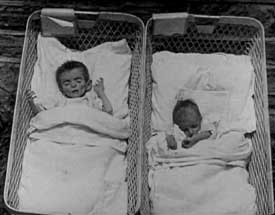 The Lone Game: A Red Cross Seal story (1915) states up fron tthat it was "produced in cooperation with the National Association fo the Study & Prevention of Tuberculosis."
The Lone Game: A Red Cross Seal story (1915) states up fron tthat it was "produced in cooperation with the National Association fo the Study & Prevention of Tuberculosis."
The melodrama that unfolds is thus infused with "social responsibility" promoting Red Cross "Christmas Seals."
An impoverished young lady, Grace (Bessie Learn), is about to lose her let room. She is on her way to see if she can get a job in a shirt scrap factory when she is struck down in the street by a trolly, scooped up in what looked like a cow-catcher or a bicycle rack.
She awakens in the hospital. A young man she knows a little, Dean (Robert Walker), has brought her flowers. He asks if she has any relatives. She says she has only a brother Phil (Wilfred Young). Phil practically raised her as they were orphaned, but he became ill from overwork & stress. He's presently recovering from tuberculosis, or so she's been told.
 In reality, unbeknownst to Grace, Phil has fallen on rough times & is working at a poorly paying clerk's job getting sicker & sicker. His emplyer had to take him to the Hillside Sanitorium, but he is evicted not long after for inability to pay for treatment. In reality, unbeknownst to Grace, Phil has fallen on rough times & is working at a poorly paying clerk's job getting sicker & sicker. His emplyer had to take him to the Hillside Sanitorium, but he is evicted not long after for inability to pay for treatment.
Meanwhile Dean -- who "contracted a cold" while at school has not been able to shake it -- discovers he too has tubercolosis. He must now fight "the lone game" of luck & will-power to recover.
That, & money, can save him. Dean's family has means so he can more successfully fight the illness than could impoverished Phil.
Grace has gotten a so-so job at a milliners. But she too is tubercular. She is in the early stages, & might have a good chance at recovery. Being poor, she is referred to a charitable "open air sanitorium."
Dean recovers thanks to the best care money can buy. Grace recovers thanks to charity. Phil suffers the torments of the dying without proper care until he is found unconscious in the streets, & never recovers. Grace thereafter promotes Christmas Seals in her brother's memory.
At a quarter-hour, The Lone game is short enough to be sufferable. It's an interesting promotional film even if the story is weak. The fact that a sister could get charitable care but no one bothered to mention this option to her even sicker brother never quite made sense.
 The "social responsibility" genre tended to rely on the same melodramatic content as films with no axe to grind, so were neither more nor less dull or cliche than any other tearjerkers.
The "social responsibility" genre tended to rely on the same melodramatic content as films with no axe to grind, so were neither more nor less dull or cliche than any other tearjerkers.
The Public & Private Care of Infants (1912) boasts that it was "Produced in Cooperation with the Russel Sage Foundation, Department of Child-Helping."
A widowed mother has infant twins, so is unable to work & care for them at the same time. Without working she cannot feed them, but if she takes a job she can't look after them.
It's an irresolvable dilemma which leads to one of the twins she is forced to board out for $1.50 a week. The other she places in an orphans asylum.
The heartsick mother can then obtain a position as a housekeeper, but can only see her child in the orphan's asylum on her one day off. It's soon all too obvious that with only one nurse per fourteen babies, none of these infants get the attention they require, no matter how well intending the staff may be.
As this is an instructional melodrama, we're shown in detail how the institute prepares meals for two hundred infants.
Without staff to insure each infant eats exactly what they require, & overcrowding as many as five to a crib, malnutrition inevitably results for some of them. Photographs of actual starving infants are horrific & pull no punches, though the assertion that it can get this bad without staff noticing is a whitewash.
 Some infants die in these conditions. Other infants are turned away because the institution cannot handle so many as they already have. Some infants die in these conditions. Other infants are turned away because the institution cannot handle so many as they already have.
Informative text cards state clearly such truisms as "Usually a mother's care, even though she be ignorant, is better for the child than an asylum."
The widowed mother's tragedy is through much of the film put aside for the pictorial lecture, but when we get back to her, it is to reveal the terrible tragedy of her child in the asylum having died.
She now has only one of the twins, & that one is in a boarding house facility, with better individual care, but where the mother can only rarely see the child at all.
As a tearjerker the film is only somewhat effective, but as an early example of cinema used for social reform, very interesting. The documentary aspect about the limitations of orphan asylums is gruesome even without exaggeration.
The film wants to suggest corrective measures. The dubious recommendation turns out to be that wealthy people who hire live-in housekeepers permit such women to bring their children into their situation. This is done for the widowed mother's remaining child.
Other social responsibility genre films from the early silent era include The Kleptomaniac (1905) & The Ex-Convict (1905).
The first is about a poor woman who steals to feed her sick daughter, versus a rich woman who steals because she's bored, & only the poor woman is punished for the crime. The latter is about a man who has served his time for crime & though now prepared to walk the straight & narrow is driven to renewed criminality by the prejudices of society.
copyright © by Paghat the Ratgirl
|


 In reality, unbeknownst to Grace, Phil has fallen on rough times & is working at a poorly paying clerk's job getting sicker & sicker. His emplyer had to take him to the Hillside Sanitorium, but he is evicted not long after for inability to pay for treatment.
In reality, unbeknownst to Grace, Phil has fallen on rough times & is working at a poorly paying clerk's job getting sicker & sicker. His emplyer had to take him to the Hillside Sanitorium, but he is evicted not long after for inability to pay for treatment.
 Some infants die in these conditions. Other infants are turned away because the institution cannot handle so many as they already have.
Some infants die in these conditions. Other infants are turned away because the institution cannot handle so many as they already have.